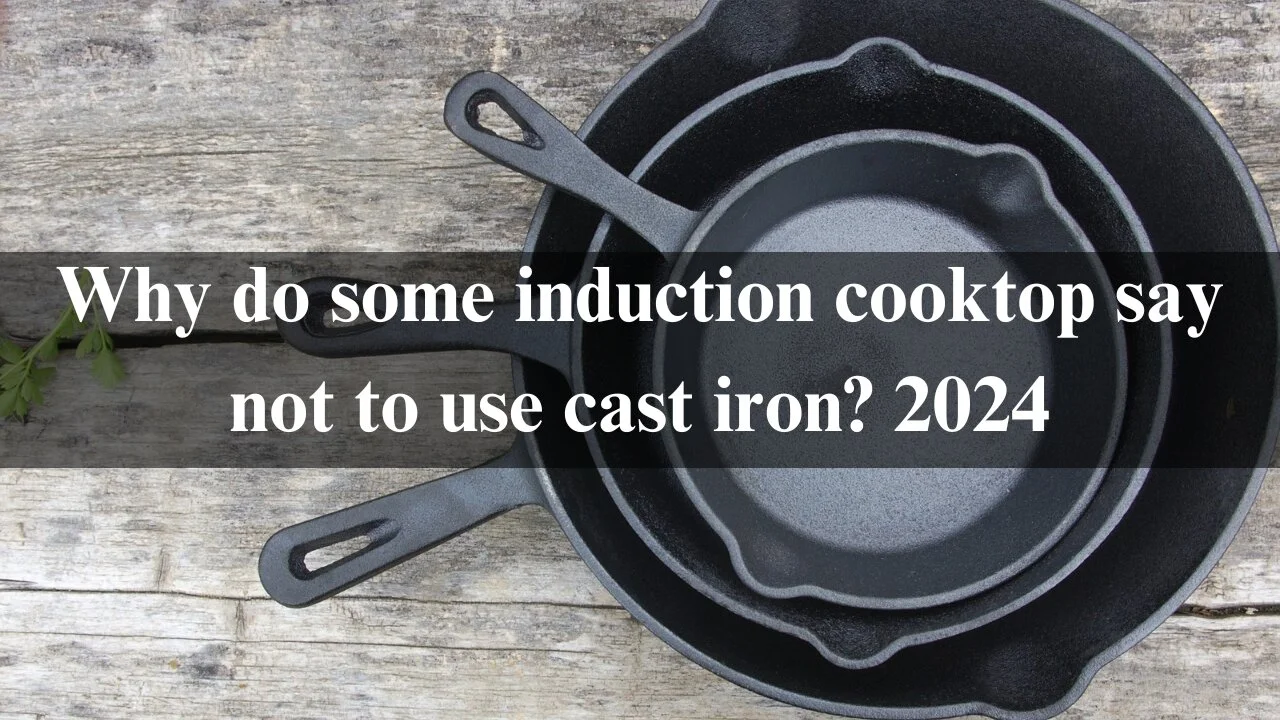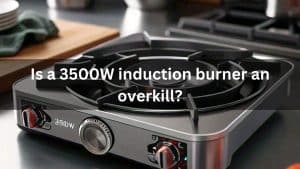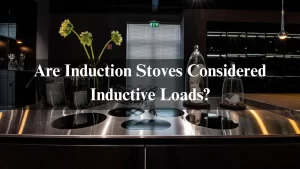Induction cooktops are the latest trend in kitchen technology, offering quick heating and precise temperature control. But if you’ve ever browsed through the manual of a new induction cooktop, you might have noticed something curious: warnings against using cast iron cookware. For many home cooks, this can feel like a disheartening restriction.
After all, cast iron is synonymous with durability and flavor enhancement! So why do some manufacturers advise against it? Let’s dive into the relationship between cast iron and induction cooking to uncover what’s really going on here. Whether you’re an avid fan of your trusty skillet or just dipping your toes into the world of induction cooking, these insights will help you navigate your kitchen choices with confidence.
Table of Contents
Understanding Cast Iron and Induction Cooktops
Use Cast iron cookware has earned a special place in kitchens worldwide. Its ability to retain heat and distribute it evenly makes it an ideal choice for various cooking techniques. From searing meats to baking cornbread, cast iron is versatile.
Induction cooktops work differently than traditional gas or electric stoves. They use electromagnetic energy to directly heat compatible cookware, creating rapid and efficient cooking. This technology requires the pots and pans used on them to be made from ferrous materials that can generate magnetic fields.
While most cast iron skillets are magnetic, their weight can pose issues. The heavy nature of these pans may not make adequate contact with the induction surface if not properly placed, leading to uneven heating or even damage over time. Understanding this dynamic helps clarify why some manufacturers express caution regarding use cast iron on induction surfaces.
Does Cast Iron Work on Induction Cooktops?
Yes, cast iron can able to work on induction cooktops. The key is the magnetic properties of the material. Induction cooking uses electromagnetic fields to directly heat pots and pans made from ferrous materials, such as cast iron.
Many cooks love using their trusty cast iron skillets because they provide excellent heat retention and a natural non-stick surface when seasoned properly. This makes them versatile for various cooking methods.
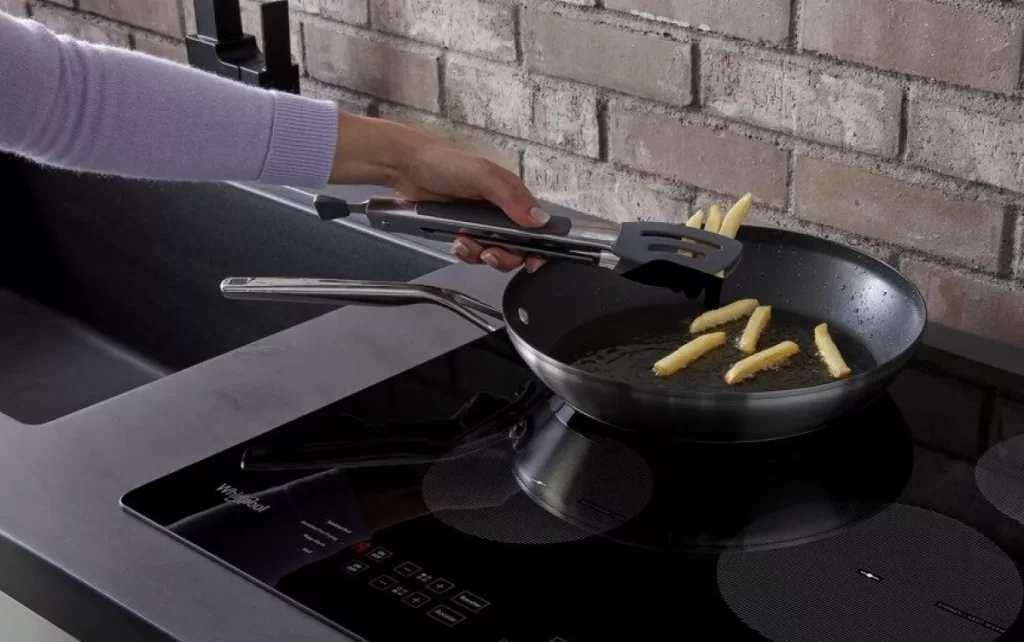
However, not all cast iron cookware will perform equally on induction surfaces. Some older or poorly manufactured pieces may lack sufficient magnetic quality. It’s essential to check if your specific cookware has a flat bottom, ensuring optimal contact with the cooktop’s surface for efficient heating.
While you can use cast iron on an induction cooktop, it’s wise to test your pan first before committing to larger meals or recipes that require precision in temperature control.
Is It Okay to Use Cast Iron on an Induction Cooktop?
Use cast iron on an induction cooktop can be a bit of a debate among cooking enthusiasts. The magnetic nature of cast iron makes it compatible with induction technology. So, yes, it will work.
However, there are some caveats to consider. Induction cooktops heat up quickly and can reach high temperatures in no time at all. This speed can cause thermal shock if the cast iron is not preheated properly or if it’s too cold when placed on the burner.
Another point to note is the weight of cast iron cookware. It’s heavy and may scratch the surface of your induction cooktop if handled carelessly. Always lift rather than slide to prevent damage.
For those who love their cast iron skillets or Dutch ovens, using them on an induction cooktop is certainly possible—just proceed with caution for optimal results.
Can Cast Iron Be Used on All Cooktops?
Cast iron is remarkably versatile, but it doesn’t play well with every cooktop.
Gas and electric coil stoves are perfect companions for cast iron skillets and Dutch ovens. The heat distribution from these sources enhances the cooking experience. However, glass-top ranges can be a bit tricky.
While you can use cast iron on a glass cooktop, caution is needed. The heavy weight might scratch or crack the surface if not handled carefully. It’s best to lift rather than slide your cookware.
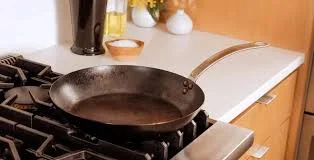
Induction cooktops also have their quirks when it comes to use cast iron. They require magnetic materials for efficient heating, so only certain cast-iron pieces will work effectively.
Ceramic and halogen tops present similar challenges as well. While they may accommodate cast iron, always check compatibility before diving in with your favorite skillet!
What Type of Cooktop is Best for use Cast Iron?
When it comes to cooking with cast iron, the type of cooktop can significantly affect your experience. Gas stoves are often favored by cast iron enthusiasts. They offer instant heat and precise control over flame levels, making them ideal for searing meats or achieving a perfect crust on cornbread.
Electric coil burners also work well with cast iron, providing steady heat distribution. These cooktops maintain temperature effectively, allowing for even cooking across the surface of your cast iron cookware.
Smooth-top electric ranges can be used too, but caution is necessary here. The flat surface requires careful handling as heavy pans may scratch or damage it if not lifted properly.
Induction cooktops have their pros and cons when using cast iron. While they heat quickly and efficiently due to magnetic technology, certain manufacturers advise against using heavier pieces due to potential scratching or impact damage on the glass top.
Choosing the best cooktop depends on personal preferences and cooking styles. Each option offers unique benefits that cater to different culinary needs while ensuring you get the most out of your beloved use cast iron pots and pans.
Challenges of Using Cast Iron on Induction Cooktops
Using cast iron on induction cooktops can present several challenges. First, the weight of cast iron cookware makes it cumbersome to maneuver. Lifting a heavy pan off the surface could lead to scratches or damage if you’re not careful.
Another issue is compatibility. Induction cooktops require magnetic materials for efficient operation. While most cast iron pans are magnetic, some older or enameled versions may not work effectively, leading to uneven heating.
Heat distribution also poses a problem. Cast iron retains heat exceptionally well, which can cause hot spots during cooking. This unevenness might result in burnt food or inadequate cooking results.
There’s the risk of scratching your cooktop’s glass surface if you slide the skillet around too carelessly. These factors make using cast iron on induction surfaces less straightforward than one might expect.
Will Cast Iron Damage an Induction Cooktop?
Many people wonder if using cast iron cookware will harm their induction cooktops. The good news is that, generally, use cast iron won’t damage the surface of an induction stove. Induction technology heats the pot directly instead of warming the cooking surface.
However, some precautions are necessary. Use cast iron pans can be quite heavy and may scratch a delicate glass top if not handled carefully. Always lift rather than slide your cookware when moving it around to avoid scratches.
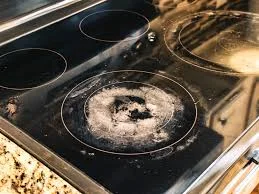
Another aspect to consider is dirt or debris stuck under the pan. This could potentially lead to scratches as well, so keeping both your cooktop and cookware clean is essential for maintaining their longevity.
While there’s no inherent risk in using cast iron on induction cooktops, mindful usage goes a long way in preserving your appliance’s condition.
What is the Main Disadvantage of Cast Iron?
One of the main disadvantages of cast iron is its weight. These cookware pieces can be incredibly heavy, making them challenging to handle, especially for those with limited strength. Lifting a large skillet or Dutch oven can feel like a workout.
Another drawback is the maintenance they require. Cast iron needs regular seasoning to maintain its non-stick surface and prevent rusting. This upkeep may deter some home cooks who prefer low-maintenance options.
Additionally, cast iron heats unevenly unless properly preheated. Those hot spots can lead to cooking inconsistencies, which can be frustrating when trying to achieve precise results in your culinary creations.
The porous nature of cast iron also means it absorbs flavors over time. While this can enhance dishes cooked in it again and again, it might not suit every recipe you attempt if you’re looking for neutral tastes from your cookware.
Will Cast Iron Crack When Heated?
Cast iron is known for its durability, but it’s not invincible. When heated too quickly or unevenly, there’s a risk of cracking.
Rapid temperature changes can be particularly problematic. For instance, moving a cold cast iron skillet directly onto a hot burner might lead to stress fractures in the metal.
Additionally, older pieces with pre-existing flaws are at greater risk. Small chips or surface imperfections can worsen under high heat.
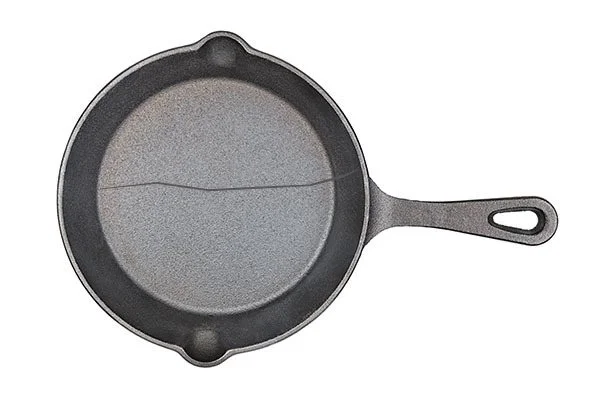
To minimize these risks, gradual heating is key. Slowly increasing the temperature allows the material to expand evenly and reduces strain on its structure.
Proper care also plays an essential role in maintaining integrity. Regular seasoning and avoiding sudden shocks will help keep your cast iron cookware in top shape as you enjoy cooking with it over time.
Will Cast Iron Damage a Glass Cooktop?
Cast iron is renowned for its durability, but when it comes to glass cooktops, caution is key. The weight of cast iron pans can pose a risk; dropping one can lead to cracks or chips in the surface.
It’s not just about impact. The rough bottom of some cast iron cookware may scratch the smooth glass surface over time. This abrasion can affect both aesthetics and performance.
Heat retention is another consideration. Cast iron retains heat exceptionally well, which might create temperature fluctuations that could stress the glass beneath it.
Using a protective barrier like a silicone mat can help mitigate these risks while enjoying your favorite cast iron skillets on a glass top stove. Always lift rather than slide your pots and pans to preserve your cooktop’s condition as much as possible.
What Happens if You Overheat Cast Iron?
Overheating cast iron can lead to several issues, compromising both the cookware and your culinary experience. When subjected to extreme temperatures, the surface of the pan can become discolored or develop a dull finish.
At high heat, food may stick more than usual. This is especially frustrating when you’re trying to achieve that perfect sear on meats or veggies.
Additionally, overheating can damage the seasoning layer that protects your cast iron. The oil used for seasoning might break down under intense heat, leaving your pan exposed and prone to rust.
Moreover, if you’re cooking with acidic ingredients in an overheated pan, it could impart unpleasant flavors into your dish.
There’s a risk of cracking if there’s a drastic temperature change after overheating—like placing a hot skillet in cold water. Treating cast iron with care ensures its longevity and performance remain intact over time.
Why Do Some Induction Cooktops Say Not to Use Cast Iron?
When it comes to using cast iron on induction cooktops, manufacturers often issue warnings for good reason. Induction technology relies on magnetic fields to generate heat directly within the cookware. Cast iron is typically magnetic, making it compatible with induction cooking in theory. However, there are several practical challenges that can arise when pairing these two.
Many induction cooktops warn against cast iron because of its weight and rough surface. The heavy nature of cast iron means that it can scratch the delicate glass surface of some induction models if not handled properly. Additionally, if a pot or pan has an uneven bottom—from years of use or manufacturing imperfections—it may not sit flat against the cooker’s surface, resulting in inefficient heating and potential damage.
Another concern centers around overheating risks associated with cast iron cookware. If left unattended or set to a high setting for too long, cast iron can become extremely hot—much hotter than necessary—and this excess heat can cause distortion over time.
Moreover, while most induction cooktops won’t be damaged by normal use with cast iron, improper handling could lead to scratches or dents on the cooktop itself. This is especially relevant given that many modern kitchens feature sleek glass surfaces designed for both aesthetics and function.
While you might still enjoy your beloved cast-iron skillets on certain types of induction hobs—taking care to avoid excessive weight and ensuring even contact—you should always heed manufacturer guidelines for optimal performance and longevity from your appliance.
How to Use Cast Iron on an Induction Stovetop Safely
How Do I Protect My Induction Cooktop from Cast Iron?
To protect your induction cooktop when using cast iron, always lift the pan instead of sliding it. You can also place a thin, heat-resistant mat or paper towel between the cooktop and the cookware to prevent scratches without interfering with the magnetic field.
How Do You Protect Cast Iron from Induction?
To protect your cast iron from potential damage due to uneven heating on an induction cooktop, ensure that the bottom of the pan is flat and clean. Regular seasoning also helps maintain its protective layer, reducing the risk of overheating.
Preheat Your Skillet Before Adding Any Oil, Fat, or Food
Preheating is essential when using cast iron on an induction cooktop. Gradually increasing the temperature prevents hot spots and ensures even cooking. Once the skillet is evenly heated, you can add oil or fat to prevent food from sticking.
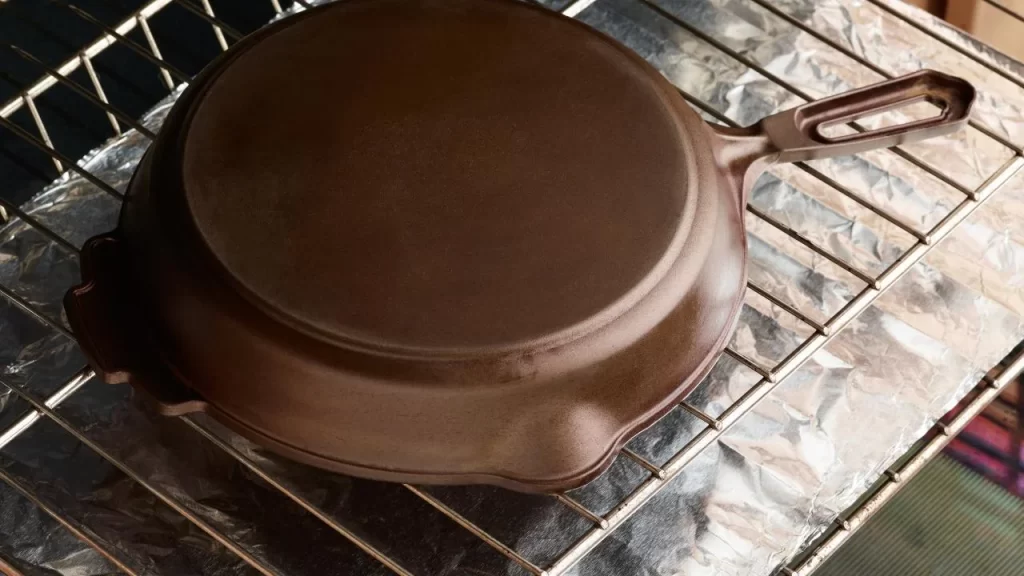
Don’t Wait Too Long to Wash Your Skillet
After cooking, don’t leave your cast iron skillet sitting too long with food residue. This can make it harder to clean and damage the seasoning. Instead, wash it while it’s still warm, using hot water and a scrub brush.
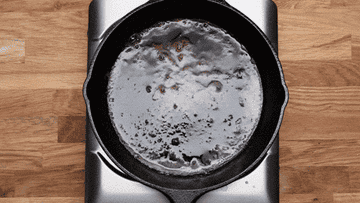
Taking Care of Your Cast Iron Cookware
How to Take Care of Your Cast Iron?
Proper care for your cast iron cookware involves regular cleaning and seasoning. This not only maintains its non-stick surface but also prevents rust and extends its lifespan.
Scrub Your Skillet Down to Its Base Layer
When cleaning, sometimes it’s necessary to scrub down to the base layer to remove old, burnt-on food or excess seasoning. Use a stiff brush and hot water—avoid soap unless absolutely necessary.
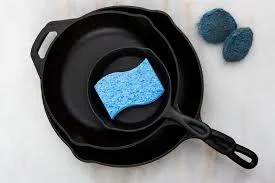
Completely Dry the Skillet to Prevent Rusting
After washing, completely dry your skillet to prevent rust. You can do this by placing it on a stovetop burner or in a hot oven for a few minutes.
Add a Thin Layer of Oil
Once dry, apply a thin layer of oil to the surface. This is the seasoning process, which protects the skillet from rust and creates a natural non-stick surface.
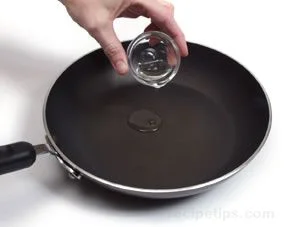
Heat in the Oven
To solidify the seasoning layer, place the skillet in an oven preheated to about 375°F (190°C) for an hour. This helps the oil bond to the metal, creating a durable, protective layer.
For a Gentle and Very Effective Cleaning Method, Scrub Your Skillet with Salt and Hot Water
If you prefer a gentler cleaning method, use coarse salt and hot water. This effectively removes food particles without stripping the seasoning.
Completely Dry the Skillet on the Stovetop or in a Hot Oven
After cleaning with salt, make sure to dry the skillet thoroughly on the stovetop or in a hot oven to prevent rust.
Add a Protective Layer of Oil
Finish by adding a thin protective layer of oil. This step is crucial for maintaining the skillet’s seasoning and preventing rust.
Things to Consider Before Buying Cast Iron Cookware for Induction Stove
What to Look for in Cast Iron Cookware
When shopping for cast iron cookware, look for pieces with smooth, flat bottoms to ensure even contact with your induction cooktop. Also, consider the weight and handle design for ease of use.
Which Cast Iron Brand is Best?
Several brands offer high-quality cast iron cookware. Lodge is a popular choice in the U.S. for its affordability and durability. Le Creuset and Staub are also excellent but come with a higher price tag due to their premium finishes and designs.
Where to Buy Induction Cookware in Cast Iron
You can buy cast iron cookware from a variety of retailers, both online and in-store. Amazon, Walmart, and specialty kitchen stores like Williams-Sonoma offer a wide range of options. Always check that the cookware is suitable for induction cooking.
Beginner Tips for Cast Iron Cooking
Cast Iron Cooking – Beginner Tips
If you’re new to cast iron cooking, start with simple dishes like grilled sandwiches or seared meats. These allow you to get used to the pan’s heat retention and distribution properties.
What is Too Hot for Cast Iron?
Cast iron can handle high temperatures, but it’s essential to avoid heating it empty for too long. This can cause the pan to overheat, which may damage the seasoning and warp the pan.
What Destroys Cast Iron?
The biggest threats to cast iron are water and acids. Leaving your pan wet or soaking it can lead to rust. Cooking acidic foods for extended periods can also damage the seasoning.
What Stove Can You Not Use Cast Iron On?
Cast iron can be used on any stove, but it’s crucial to exercise caution on glass-top stoves, including induction cooktops. The weight and rough texture of cast iron can damage these surfaces if not handled carefully.
Do Top Chefs Use Cast Iron?
Many top chefs use cast iron cookware due to its superior heat retention and versatility. It’s often their go-to for tasks like searing steaks, baking cornbread, or even making delicate sauces.
Why Did We Stop Using Cast Iron?
While cast iron was once a staple in every kitchen, its use declined due to the rise of lighter, non-stick alternatives. However, cast iron has seen a resurgence in recent years as more people appreciate its durability and cooking performance.
Related Articles:
Can I Magnetise Pots And Pans That Are Older?
Does Induction Cookware Have To Have Flat Bottoms? Info 2024
Why Doesn’t Cookware Stick To Induction Cooktops? In 2024
Ultimate Guide To Pan Compatibility Of Induction Cooktop In 2024
Conclusion
In conclusion, while cast iron can be used on induction cooktops, it’s essential to handle it with care to avoid damaging the surface or causing performance issues. By lifting the cookware instead of sliding it and ensuring the bottom is smooth and even, you can enjoy the benefits of cast iron without compromising your induction cooktop’s efficiency and durability.
FAQs
Can you use a cast iron skillet on an induction cooktop?
Yes, but with caution to avoid damaging the cooktop’s surface.
What are the risks of using cast iron on an induction cooktop?
The primary risks include scratching the cooktop and uneven heating if the pan’s bottom isn’t flat.
How can I prevent my induction cooktop from being scratched?
Use a cooktop protector, lift rather than slide your cookware, and ensure the bottom of your cookware is smooth.
Are there any induction cooktops specifically designed for cast iron?
Some high-end models are more robust and can handle cast iron better, but always check the manufacturer’s recommendations.

